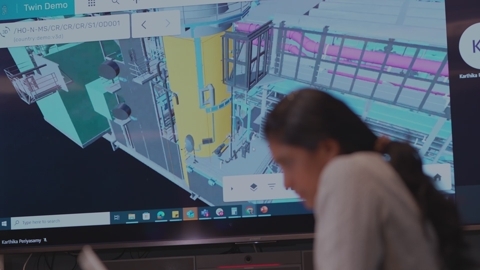
Nå er Karthika Periyasamy
et av Norges største forbilder for kvinner i tech.
Hun presset seg
gjennom et umulig nåløye for statlig
ingeniørutdanning
i India.
Hun presset seg
gjennom et umulig nåløye for statlig
ingeniørutdanning
i India.

Now, Karthika Periyasamy is one of Norway's biggest role models for women in tech.
She pushed through an impossible needle's eye for state engineering education in India.

Now, Karthika Periyasamy is one of Norway's biggest role models for women in tech.
She pushed through an impossible needle's eye for state engineering education in India.
Journalist: Tina Aasen
Photo/video: Björn Audunn Blöndal
Illustration: Marius Halvorsen
The Problem solver
Journalist: Tina Aasen
Photo/video: Björn Audunn Blöndal
Illustration: Marius Halvorsen
The Problem solver
"It was my idea to move here, I couldn't even complain!"
She has parked her car in the basement and hurried through the door to Kongsberg Digital at Lysaker. Grey sweater, relaxed pants, broad smile, jetlag. Karthika Periyasamy was recently in Houston for a conference, and her circadian rhythm is off.
“Ten years ago, companies were not as open to foreigners, let's be honest about that.”
Now she sips morning coffee from a "Game Changers" cup. She is definitely someone who contributes to changing the rules of the game. In March, she was named one of the country's top 50 women in tech.
Karthika Periyasamy is the senior director for Kognitwin Product Integration. They create digital twins of oil platforms, and she leads several teams that total around 70 technologists, mostly men. Her career did not come for free.
"My husband warned me that it might be difficult to get a job in IT. So, I said, fine! Then I'll be a housewife. I had a small baby and was tired, but it took two weeks before my head started to itch, ha- ha. I couldn't just stay at home and clean and cook.

Da problemet var løst, fikk hun ikke bare ett tilbud, men flere. Hun valgte Kongsberg Gruppen, startet som junior-utvikler og steg raskt i gradene.
– I India ledet jeg et team, men jeg kunne ikke forvente å gå rett inn i en lederrolle i et nytt land, sier Karthika, som var eneste kvinne i en avdeling med tjue menn.
– Det gikk bra. Men noen ganger i møter hvor beslutninger skulle tas, tenkte jeg, ok, jeg er en minoritet her. Jeg ble respektert, men det kunne være krevende å være den eneste kvinnelige representanten i beslutningsmøtene.
Familien flyttet fra India for å prøve noe nytt, mannen kjente Norge fra før gjennom jobben. Han var skeptisk, hun var gira – og angret som en hund. Barrieren var språket, og det måtte hun fikse. Hun lærte seg norsk på tre måneder.
– Jaja, bare nok norsk til å komme meg gjennom jobbintervjuene, parerer hun og vifter vekk hvilken bragd det er.
Lærte seg norsk på tre måneder

– Det gikk bra. Men noen ganger i møter hvor beslutninger skulle tas, tenkte jeg, ok, jeg er en minoritet her. Jeg ble respektert, men det kunne være krevende å være den eneste kvinnelige representanten i beslutningsmøtene.
Da problemet var løst, fikk hun ikke bare ett tilbud, men flere. Hun valgte Kongsberg Gruppen, startet som junior-utvikler og steg raskt i gradene.
– I India ledet jeg et team, men jeg kunne ikke forvente å gå rett inn i en lederrolle i et nytt land, sier Karthika, som var eneste kvinne i en avdeling med tjue menn.
Familien flyttet fra India for å prøve noe nytt, mannen kjente Norge fra før gjennom jobben. Han var skeptisk, hun var gira – og angret som en hund. Barrieren var språket, og det måtte hun fikse. Hun lærte seg norsk på tre måneder.
– Jaja, bare nok norsk til å komme meg gjennom jobbintervjuene, parerer hun og vifter vekk hvilken bragd det er.
Lærte seg norsk på tre måneder

The family moved from India to try something new; her husband knew Norway from his job. He was skeptical, she was excited - and regretted it like a dog. The barrier was the language, and she had to fix that. She learned Norwegian in three months.
"Yeah, just enough Norwegian to get through job interviews," she parries, waving away what an achievement it is.
Once the problem was solved, she got not just one offer, but several. She chose Kongsberg Gruppen, started as a junior developer, and quickly climbed the ranks.
"In India, I led a team, but I couldn't expect to go straight into a leadership role in a new country," says Karthika, who was the only woman in a department of twenty men.
"It went well. But sometimes in meetings where decisions were to be made, I thought, okay, I'm a minority here. I was respected, but it could be challenging to be the only female representative in the decision-making meetings."
Karthika gained the leadership position at Kongsberg Digital seven years ago when the company was established. The world looks different now. She is no longer the only woman among men, and she is accompanied by many female leaders. For Kongsberg Digital, diversity is crucial to foster innovation, and the future recruitment looks promising, considering that the percentage of female applicants to higher IT education rose by 20 percent this year.
Learned Norwegian in three months
The reason for this, she believes, is that women's and men's brains operate differently.
"My experience is that men's brains are designed to do certain things very well, while women are better at having multiple thoughts in their heads at the same time. We tackle tasks from different perspectives, that’s why a balance between genders helps us to make good decisions. What would happen if society consisted only of men?"
She laughs loudly at the rhetorical question. Her daughter was one year old when they moved to Norway. Now she is 13, with a five-year-old brother. They recently moved to rural Lier, gone is the longing for a densely populated India.
"Now when I'm in India, I think: oh-no, there are people everywhere! The silence in Norway was terribly boring at first, but now I love it."
Karthika took on the leadership position at Kongsberg Digital seven years ago when the company was established. The world looks different now. She is no longer the sole woman among men, and she is accompanied by many female leaders. For Kongsberg Digital, diversity is crucial for fostering innovation, and the outlook for future recruitment is promising, considering that the percentage of female applicants for higher IT education increased by 20 percent this year.
We have different perspectives

Karthika and colleague Irfan Ali i Kongsberg Digital.
It was not smooth sailing. Everyone who wants to take engineering education at a state university must go through a challenging exam. The competition is extreme. Karthika had only one ticket chance, her parents were farmers and could not send her to expensive private school. Many hundreds of thousands of hopefuls came from the big cities, hordes of bright people, to fight for six-to-seven hundred places at level 1 – the top tier with the very best minds. The girl from the village passed the narrow needle's eye and was already a role model.
When she graduated from the university after four years and with a steady job in her pocket, she was not only the first female engineer in the village, but the very first engineer.
She grew up in a village in Tamil Nadu, southern India. Her elder sister got married right after high school, and for Karthika, that was out of the question.
Through an impossible needle's eye
"I wanted to study, and my parents supported me. I've always loved solving problems and landed on becoming a computer engineer."
Karthika Periyasamy
"If men develop an app and test it on men, we risk that it won't be user-friendly for women. Much of the technology does not appeal to women at all, and we can do something about that"
Karthika Periyasamy



"We must start with the parents, they must push the girls forward. And the rest of us must make technology fun and relevant for them. It doesn't help if Kongsberg Gruppen or other companies are ready to welcome them – if there are not more women to choose from, we won't get any further."

"Each team consists of eight children, and I have five girls on my team!"
She claps her hands enthusiastically. This is the first time she has experienced girls being in the majority.

This is not something Kartikha makes up, she has seen it. Seven years ago, she started YoungCoderz with a friend, which runs programming courses for children from six years and up at several international schools. She is now taking a break from YoungCoderz, but she also leads a team participating in the First Lego League. They compete to solve missions using coding and Lego.

"The everyday life of technologists consists of solving problems in the real world. It's not something scary, not something you need to steer clear of. I guarantee that if children are introduced to technology in a way that is relevant to their lives, everyone can become interested," she says.

Kongsberg Digital's bright and modern premises have opened, but shielded landscapes, sofa groups, and meeting rooms where people sit wherever they want. Karthika shows the way, talks with colleagues.
Catching girls with Lego


"We must start with the parents, they must push the girls forward. And the rest of us must make technology fun and relevant for them. It doesn't help if Kongsberg Gruppen or other companies are ready to welcome them – if there are not more women to choose from, we won't get any further."

"Each team consists of eight children, and I have five girls on my team!"
She claps her hands enthusiastically. This is the first time she has experienced girls being in the majority.

This is not something Kartikha makes up, she has seen it. Seven years ago, she started YoungCoderz with a friend, which runs programming courses for children from six years and up at several international schools. She is now taking a break from YoungCoderz, but she also leads a team participating in the First Lego League. They compete to solve missions using coding and Lego.

"The everyday life of technologists consists of solving problems in the real world. It's not something scary, not something you need to steer clear of. I guarantee that if children are introduced to technology in a way that is relevant to their lives, everyone can become interested," she says.

Kongsberg Digital's bright and modern premises have opened, but shielded landscapes, sofa groups, and meeting rooms where people sit wherever they want. Karthika shows the way, talks with colleagues.
Catching girls with Lego




"We must start with the parents, they must push the girls forward. And the rest of us must make technology fun and relevant for them. It doesn't help if Kongsberg Gruppen or other companies are ready to welcome them – if there are not more women to choose from, we won't get any further."

"Each team consists of eight children, and I have five girls on my team!"
She claps her hands enthusiastically. This is the first time she has experienced girls being in the majority.

This is not something Kartikha makes up, she has seen it. Seven years ago, she started YoungCoderz with a friend, which runs programming courses for children from six years and up at several international schools. She is now taking a break from YoungCoderz, but she also leads a team participating in the First Lego League. They compete to solve missions using coding and Lego.

"The everyday life of technologists consists of solving problems in the real world. It's not something scary, not something you need to steer clear of. I guarantee that if children are introduced to technology in a way that is relevant to their lives, everyone can become interested," she says.

Kongsberg Digital's bright and modern premises have opened, but shielded landscapes, sofa groups, and meeting rooms where people sit wherever they want. Karthika shows the way, talks with colleagues.
Catching girls with Lego



Lack of women in tech has consequences. When technology is tested on men and designed for men, the result can be discriminatory. Women freeze at work because the ideal temperature is set according to men, Google's voice recognition understands male voices much better than female, and women are far more likely to be seriously injured in car accidents than men.
Other side effects are about the big picture. Researchers warn that lack of equality in the tech world limits our opportunities to solve future challenges. The world becomes poorer if half of the population is not involved in deciding how it should look. After all, we use technology for almost everything.
Women needed for future solutions
Breaking down stereotypes
"Karthika Periyasamy is an important role model for women in tech. Women need role models they can identify with," says Anne Gro Kjørstad, corporate HR at Kongsberg Gruppen.
Kongsberg Gruppen is involved, among other things, in the girl project Ada NTNU, which aims to motivate girls to complete their education and show what job opportunities they have, and in NHO's recruitment project Girls and Technology.
"I believe dialogue with the young has a good effect. There are some stereotypes around technology, and many are surprised by what a job in the tech field can involve," says Kjørstad.

Bryter ned stereotyper
– Karthika Periyasamy er en viktig rollemodell for kvinner i tech. Kvinner trenger forbilder de identifiserer seg med, sier Anne Gro Kjørstad, konsern HR i Kongsberg Gruppen.
Kongsberg Gruppen er blant annet involvert i jenteprosjektet Ada NTNU, som skal motivere jenter til å fullføre utdanningen og vise hvilke jobbmuligheter de har, og i NHOs rekrutteringsprosjekt Jenter og teknologi.
– Jeg tror dialog med de unge har god effekt. Det fins endel stereotypier rundt teknologi, og mange blir overrasket over hva en jobb innen teknologifaget kan innebære, sier Kjørstad.
Kåringen av Norges 50 fremste tech-kvinner arrangeres av Abelia, NHO og Oda-Nettverk. Målet er å løfte frem talenter og forbilder som kan inspirere kvinner til å velge teknologi.

Breaking down stereotypes
"Karthika Periyasamy is an important role model for women in tech. Women need role models they can identify with," says Anne Gro Kjørstad, corporate HR at Kongsberg Gruppen.
Kongsberg Gruppen is involved, among other things, in the girl project Ada NTNU, which aims to motivate girls to complete their education and show what job opportunities they have, and in NHO's recruitment project Girls and Technology.
"I believe dialogue with the young has a good effect. There are some stereotypes around technology, and many are surprised by what a job in the tech field can involve," says Kjørstad.

The proportion of women is slowly rising
Of 1000 employees in Kongsberg Digital 23 percent are women.
The number of male applicants is still almost double.
Since 2016, the proportion of women in the technology industry has increased by only 2.2 percent.
The number of female applicants with IT education as their first choice increased by 20 percent from 2022-2023.
More stories from Kongsberg Gruppen




– Det gir oss muligheten til å ta pulsen på jorda
– Det gir oss muligheten til å ta pulsen på jorda
– Et industrieventyr gjennom 200 år
– Hvis du er opptatt av det nyeste innen robotikk, er dette stedet






